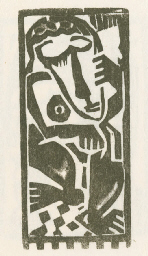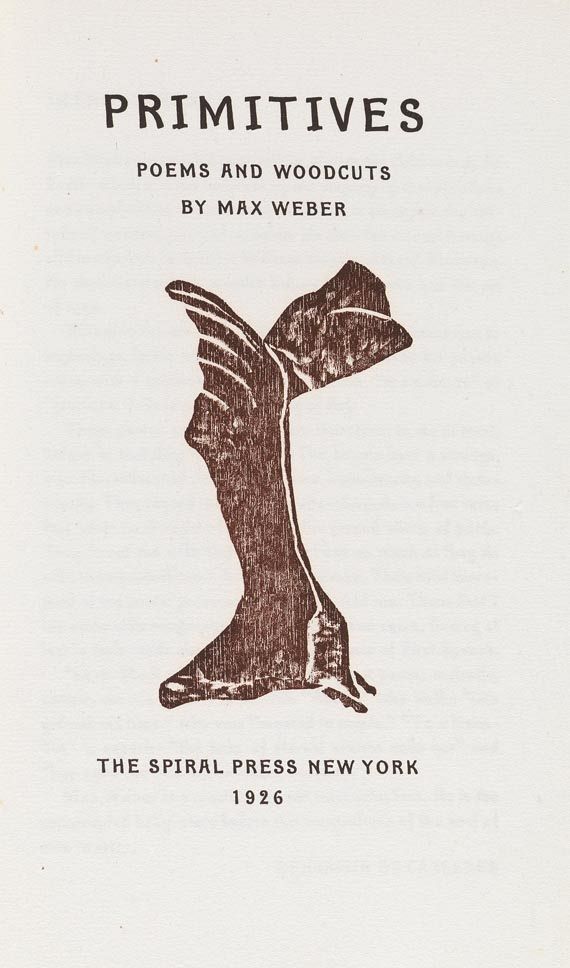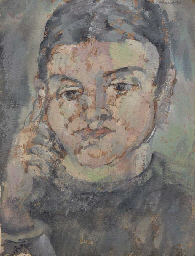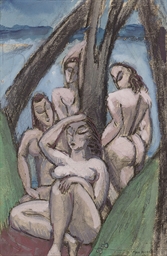Max Weber American, 1881-1961 Woman on Chaise Lounge [sic], 1921 Signed Max Weber (lr) Oil on canvas 24 1/4 x 31 inches Provenance: Estate of the artist Frances Abrams Weber (Mrs. Max Weber Bernard Danenberg Galleries, New York Private collection, New York At the forefront of the American avant-garde in the early twentieth century, around 1920 Max Weber turned away from a cubistic approach to painting and moved toward more representational imagery. For the next twenty years, he favored what Percy North has described as "massively robust nudes with stylized, mask-like faces." [Percy North, Max Weber's Women, Los Angeles, Jack Rutberg Fine Arts, Inc., 1996, p. 39] His figures in this phase of his career are monumental in form, resonating with the rich tradition of classical figure painters such as Titian, Manet, Goya and Cezanne. In the present work, the nude odalisque reclining on a divan is as much a descendant of the alluring women featured in Manet's Olympia [Musée D'Orsay, Paris], Goya's Maja desnuda [Museo del Prado, Madrid], and Titian's Venus of Urbino [Uffizi Gallery, Florence], as she is a tribute to the muscular bathers of Paul Cezanne. A second woman observing from behind a low wall is a motif seen in another painting by Weber of the same period, Alone, in which several figures stand behind a vertical panel, regarding a seated muscular male. In his insightful essay from 1930, Holger Cahill discussed Weber's distinctive approach to the figure: "He is not concerned with female charm, sexual or otherwise, with appealing to the reserve of amorous feelings which, so psychologists say, is in all of us. The colors which he uses for his flesh tones are not used to suggest the seductive colors of flesh, but result from his understanding of the use of color as design, the lovely, muted orchestration of subtle gray tones, the excitement of interharmonized tints, the massive counterpoint of color areas. "Weber is concerned primarily with architecture and solidity, with a logical structure of forms distributed in three dimensions, an equilibrium of weight. This is the key to his use of heavy figures. His plastic interpretation of these figures is guided by his conception of gesture, an arm stretched out, the poise of a head, the relaxation of a limb. His aim is to realize in plastic terms intervals of human significance ranging from ecstasy to repose." [Holger Cahill, Max Weber New York: The Downtown Gallery, 1930, p. 40] Estate of Jeanette Levitt
Lined. New stretchers. No apparent restoration under UV examination, but signature appears to fluoresce and may have been strengthened.
Max Weber American, 1881-1961 Woman on Chaise Lounge [sic], 1921 Signed Max Weber (lr) Oil on canvas 24 1/4 x 31 inches Provenance: Estate of the artist Frances Abrams Weber (Mrs. Max Weber Bernard Danenberg Galleries, New York Private collection, New York At the forefront of the American avant-garde in the early twentieth century, around 1920 Max Weber turned away from a cubistic approach to painting and moved toward more representational imagery. For the next twenty years, he favored what Percy North has described as "massively robust nudes with stylized, mask-like faces." [Percy North, Max Weber's Women, Los Angeles, Jack Rutberg Fine Arts, Inc., 1996, p. 39] His figures in this phase of his career are monumental in form, resonating with the rich tradition of classical figure painters such as Titian, Manet, Goya and Cezanne. In the present work, the nude odalisque reclining on a divan is as much a descendant of the alluring women featured in Manet's Olympia [Musée D'Orsay, Paris], Goya's Maja desnuda [Museo del Prado, Madrid], and Titian's Venus of Urbino [Uffizi Gallery, Florence], as she is a tribute to the muscular bathers of Paul Cezanne. A second woman observing from behind a low wall is a motif seen in another painting by Weber of the same period, Alone, in which several figures stand behind a vertical panel, regarding a seated muscular male. In his insightful essay from 1930, Holger Cahill discussed Weber's distinctive approach to the figure: "He is not concerned with female charm, sexual or otherwise, with appealing to the reserve of amorous feelings which, so psychologists say, is in all of us. The colors which he uses for his flesh tones are not used to suggest the seductive colors of flesh, but result from his understanding of the use of color as design, the lovely, muted orchestration of subtle gray tones, the excitement of interharmonized tints, the massive counterpoint of color areas. "Weber is concerned primarily with architecture and solidity, with a logical structure of forms distributed in three dimensions, an equilibrium of weight. This is the key to his use of heavy figures. His plastic interpretation of these figures is guided by his conception of gesture, an arm stretched out, the poise of a head, the relaxation of a limb. His aim is to realize in plastic terms intervals of human significance ranging from ecstasy to repose." [Holger Cahill, Max Weber New York: The Downtown Gallery, 1930, p. 40] Estate of Jeanette Levitt
Lined. New stretchers. No apparent restoration under UV examination, but signature appears to fluoresce and may have been strengthened.















Testen Sie LotSearch und seine Premium-Features 7 Tage - ohne Kosten!
Lassen Sie sich automatisch über neue Objekte in kommenden Auktionen benachrichtigen.
Suchauftrag anlegen